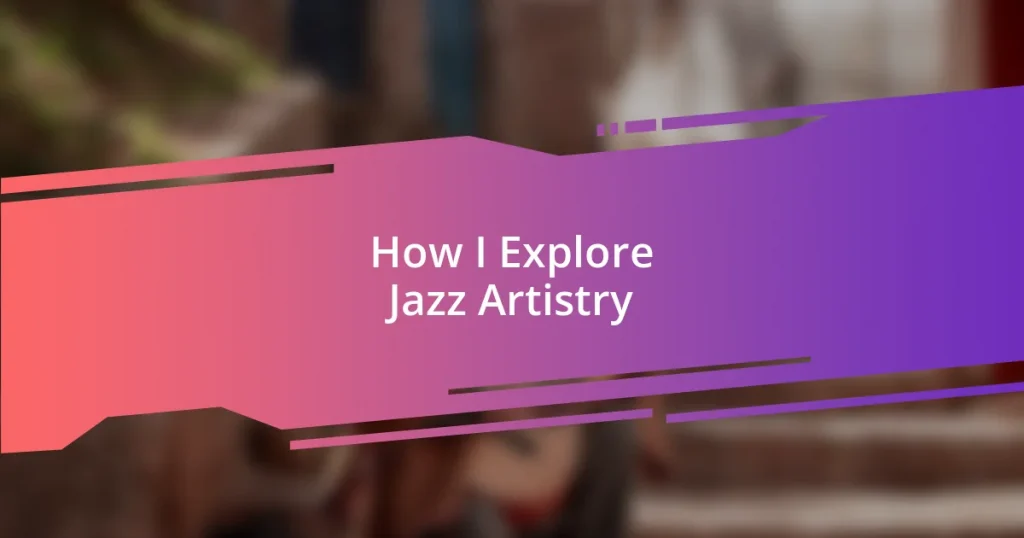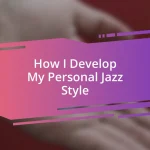Key takeaways:
- Jazz artistry is defined by its improvisational nature, emotional storytelling, and the ability to create deep connections between musicians and their audiences.
- Key elements of jazz include improvisation, swing, and harmony, each contributing to the genre’s dynamic energy and emotional depth.
- Resources like masterclasses, books, and live performances are essential for understanding and appreciating jazz, as they enhance both personal exploration and collective experience.
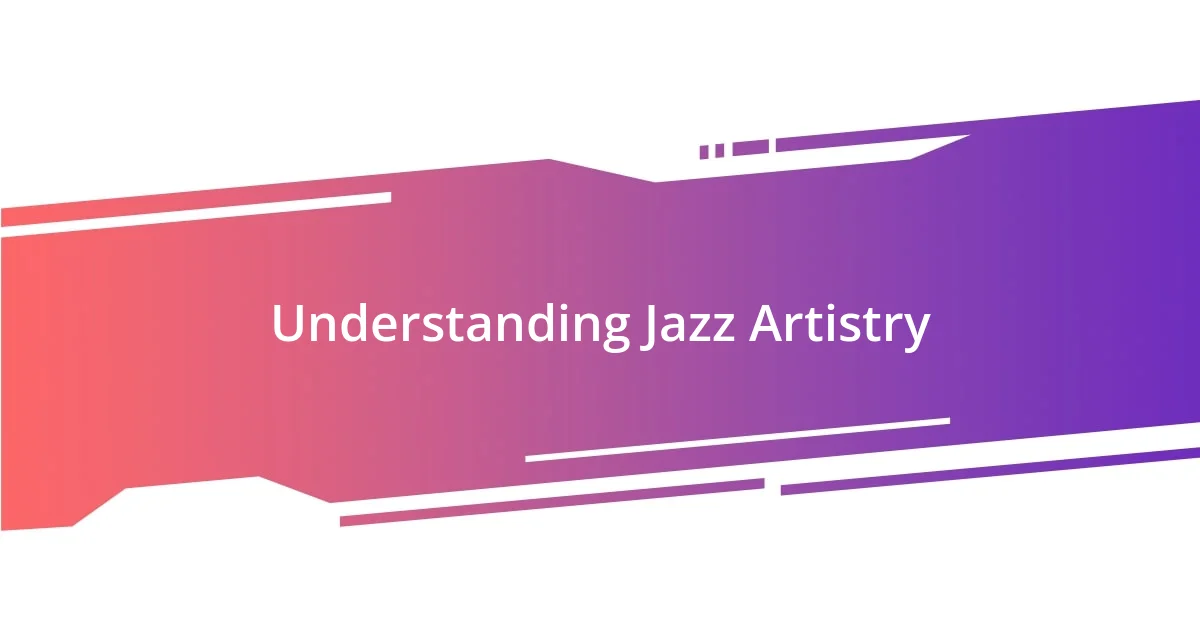
Understanding Jazz Artistry
Jazz artistry is a rich tapestry woven from diverse influences, be it the raw emotion of blues or the intricate rhythms of African and Caribbean music. I often find myself lost in the improvisational brilliance of a jazz solo, marveling at how musicians harness spontaneity. Isn’t it fascinating how they can transform a simple melody into a complex dialogue, expressing their innermost feelings in real-time?
The heart of jazz lies in its ability to speak without words. Just think about the swell of a saxophone or the punch of a trumpet; each note feels like it’s telling a story. I remember attending a live performance where the saxophonist locked eyes with the drummer, and in that moment, their unspoken connection elevated the music to another level. Can you feel that magic? It’s what makes jazz so personal and immersive.
Understanding jazz artistry requires more than just listening; it demands an emotional engagement with the music. I often reflect on how each artist leaves a unique fingerprint on their performance, creating something that resonates with my experiences. Have you ever listened to a piece and felt completely transported? That’s the power of jazz – it’s not just a genre; it’s an emotional journey that invites us to explore our own feelings and histories.

Key Elements of Jazz Music
Jazz music is built on several key elements that define its unique character. One standout feature is improvisation, wherein musicians spontaneously create melodies and harmonies. I’ve always been amazed watching a pianist break away from the written score, crafting intricate riffs that seemed to arise from thin air. This free-form expression turns every performance into a fresh experience, leaving listeners in suspense.
Another vital aspect is swing, the rhythmic feel that gives jazz its driving pulse. Imagine tapping your feet to the uneven kick of a bassist — it feels almost alive, doesn’t it? I recall a night at a jazz club where the band played a swinging number that sent shivers down my spine. You could feel the audience pulse with the beat, as if the music was a shared heartbeat. Isn’t it incredible how swing can elevate energy and mood collectively?
Finally, let’s not overlook harmony. Jazz often experiments with complex chords, creating a rich tapestry of sound that keeps us on our toes. For instance, I’ve been captivated by how a simple chord progression can shift under a musician’s fingers, offering new layers of emotional depth. Each note can stir feelings of joy, melancholy, or nostalgia, taking the listener on a profound journey. When I hear these harmonic shifts, I often find myself reflecting on my own life’s experiences and emotions.
| Element | Description |
|---|---|
| Improvisation | Spontaneous melody creation, making each performance unique. |
| Swing | A rhythmic feel that drives the music and energizes listeners. |
| Harmony | Complex chords that add depth and evoke emotions. |
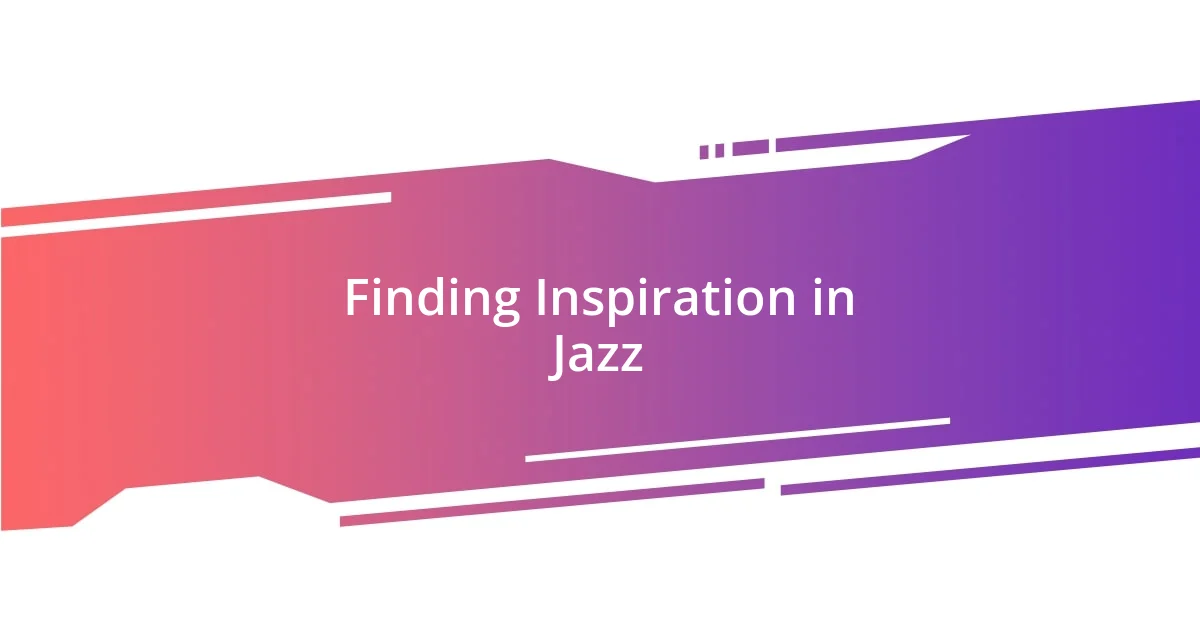
Finding Inspiration in Jazz
Finding inspiration in jazz often starts with the unexpected moments that ignite my creativity. There’s something about the spontaneity of live performances that can immediately change my perspective. I remember one night at an outdoor jazz festival when the trumpet player took an extended solo that seemed to resonate with the stars above. Each note he played felt like an invitation to explore my own emotions, drawing out memories I didn’t even know were there. That connection, where the artist’s expression meets my inner world, is pure magic.
When I listen to jazz, I find inspiration in its unique blend of tradition and innovation. It’s like a conversation between the past and the present, where each artist builds on what has come before them while forging their own identity. Here are some elements that often inspire me:
- Emotional storytelling: Jazz musicians convey deep feelings, allowing me to connect with my own emotions.
- Cultural fusion: The diversity of jazz influences reflects a rich history, reminding me of the beauty of shared experiences.
- Improvisational freedom: The art of improvisation encourages me to embrace spontaneity in my own creative pursuits.
- Unique interpretations: Hearing different renditions of classic pieces reveals how personal expression can transform familiar melodies.
Every single performance invites me to discover new layers of inspiration, reminding me just how boundless this artistry can be.

Techniques for Jazz Improvisation
Improvisation in jazz often starts with a sense of freedom that I find exhilarating. I remember jamming with a group of musicians, and there was a moment when I lost myself in a solo. The thrill of creating something new, right in that instant, felt like riding a wave — unpredictable, yet exhilarating. Isn’t it fantastic how each musician adds their unique voice, transforming a simple chord progression into a dynamic conversation?
Another technique involves using scales creatively, playing around with the major and minor modes. I’ve noticed that some of my favorite jazz artists incorporate the blues scale, adding a soulful grit that captivates listeners. When I dive into this scale in my practice sessions, it opens up pathways to express my own feelings, whether it’s joy or melancholy. Don’t you think that connecting with the underlying emotions through scales can elevate an improvisation into something deeply moving?
Chords are just as important in my improvisational journey. I often experiment with extended chords and altered tensions, which bring a richness to my sound. I recall a session where I explored a dominant seventh chord, emphasizing its ninth and thirteenth extensions. The resulting harmonic depth was like painting with vibrant colors on a canvas. Have you ever played a chord that made you feel an unexpected rush of emotion? It’s those moments, fueled by creativity, that keep the spirit of jazz alive, making every note count.

Analyzing Great Jazz Performers
When I delve into the artistry of jazz performers, I often find myself captivated by their unique vocal styles and techniques. I remember watching a renowned vocalist perform live, their voice weaving effortlessly through the melodies, each note dripping with emotion. This experience made me ponder: how does a performer manage to convey such depth through simply their voice? It’s the way they manipulate dynamics – soft whispers that draw you in and powerful crescendos that make your heart race. It’s not just singing; it’s an intimate conversation with the audience.
If I think about instrumentalists like John Coltrane or Miles Davis, it’s their fearless exploration of sound that stands out to me. One time, while practicing a piece inspired by Coltrane’s work, I experimented with circular breathing – a technique I’ve long admired for its ability to produce endless notes. I felt a connection to the essence of his artistry, as if I was channeling that same relentless pursuit of musical expression. Have you ever tried to push your limits in music? It’s these moments that transform practice into a journey of self-discovery.
Great jazz performers often have an innate ability to collaborate and communicate with their bandmates, creating a synergy that resonates deeply. I once sat in on a rehearsal where the drummer and bassist became almost telepathic in their playing. As they shifted grooves seamlessly, I realized how vital this connection is in jazz, allowing for spontaneous decisions that can elevate a performance. Don’t you love how, in those instances of pure connection, every musician is both a leader and a follower, dancing together in a beautiful chaos? This is the heartbeat of jazz artistry, where individual expression and collective harmony intertwine.
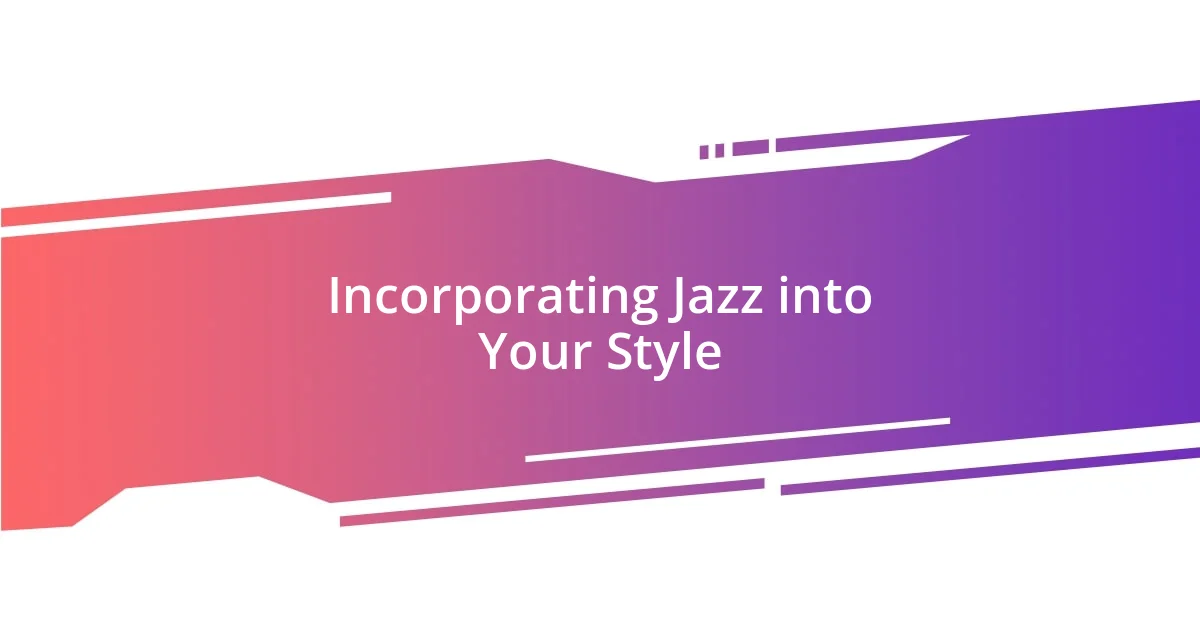
Incorporating Jazz into Your Style
Incorporating jazz into your personal style is all about embracing its improvisational spirit. I remember the first time I decided to wear a bright, patterned shirt to a jam session instead of my usual muted tones. The moment I walked in, I felt an instant shift in energy. It’s amazing how a single choice in fashion can elevate your confidence and invite a more creative expression, much like how a vibrant solo can ignite a whole ensemble.
Accessorizing thoughtfully is another way to infuse jazz into your style. Picture this: I once added a simple fedora to my outfit, and it instantly gave me a sense of timeless coolness reminiscent of my jazz heroes. I see those moments reflected in the way I play—bold and distinctive. Isn’t it fascinating how our visual choices can echo our musical tastes? Each accessory can serve as a conversation starter, just like the unique licks and riffs that build the essence of a great jazz performance.
Lastly, consider the rhythm of your lifestyle as a nod to jazz. I’ve found that integrating spontaneity into my wardrobe choices has led me to discover fresh combinations I’d never have considered before. For instance, pairing casual streetwear with more elegant pieces allows me to blend styles and create a harmonious look. How does this feel when you step outside your comfort zone? It’s liberating! Just as jazz musicians play with spontaneity, experimenting with your attire can pave the way for new creative expressions and boost your overall vibe.

Resources for Jazz Learning
In my journey of learning jazz, I’ve discovered a wealth of resources that truly resonate with my passion. One of my favorite online platforms is Jazz at Lincoln Center’s site, where you can access a treasure trove of masterclasses. I remember tuning into a session led by Wynton Marsalis, whose insights on improvisation changed my entire perspective on playing. I found it invaluable to see how a master articulates his creative process and how I could apply those lessons in real time.
Books are also crucial in my exploration of jazz artistry. I still cherish my copy of “The Jazz Theory Book” by Mark Levine. It’s been my companion as I navigate complex chord changes and structures, demystifying concepts I once found elusive. Have you ever felt that rush of understanding when a challenging idea suddenly clicks? That’s exactly how I felt analyzing its chapters. Each page felt like a stepping stone, guiding me deeper into jazz’s intricate world.
Lastly, I can’t overlook the importance of live music in my learning process. Attending jam sessions has transformed my understanding of how jazz thrives on collaboration. I vividly recall a night at a local jazz café, where each musician seemed to feed off the others’ energy. It was an eye-opening experience, witnessing this spontaneous exchange firsthand. How do you think participating in such events could shift your perspective on performance? For me, it’s a reminder that jazz is not just about individual prowess; it’s a communal experience that enriches every player involved.










